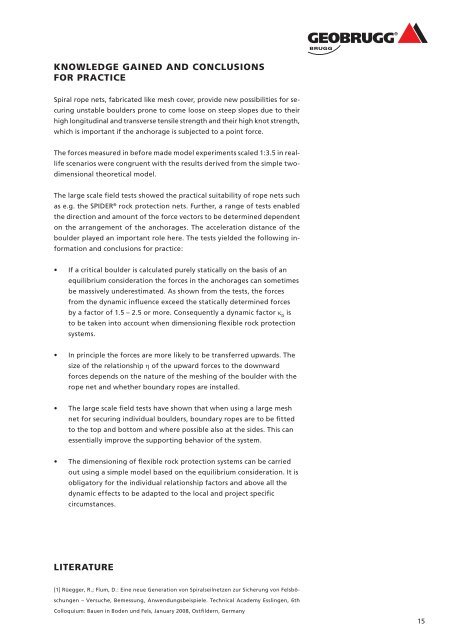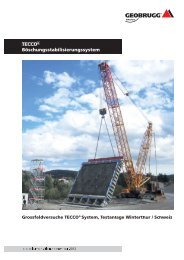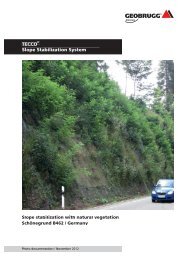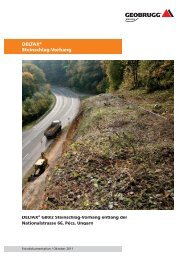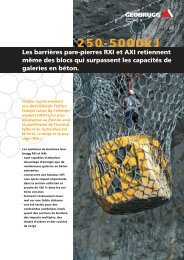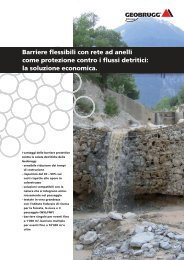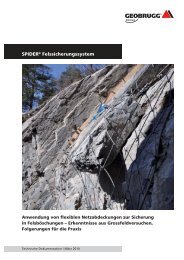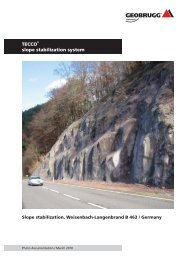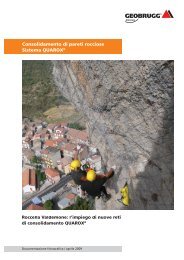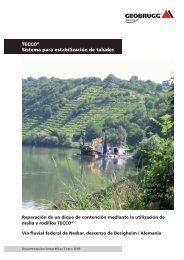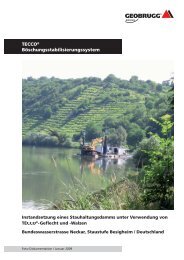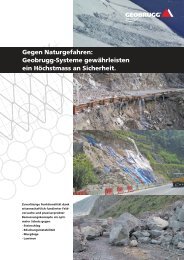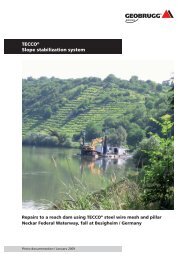SPIDER® Rock protection system - Geobrugg AG
SPIDER® Rock protection system - Geobrugg AG
SPIDER® Rock protection system - Geobrugg AG
You also want an ePaper? Increase the reach of your titles
YUMPU automatically turns print PDFs into web optimized ePapers that Google loves.
KNOWLEDGE GAINED AND CONCLUSIONS<br />
FOR PRACTICE<br />
Spiral rope nets, fabricated like mesh cover, provide new possibilities for securing<br />
unstable boulders prone to come loose on steep slopes due to their<br />
high longitudinal and transverse tensile strength and their high knot strength,<br />
which is important if the anchorage is subjected to a point force.<br />
The forces measured in before made model experiments scaled 1:3.5 in reallife<br />
scenarios were congruent with the results derived from the simple twodimensional<br />
theoretical model.<br />
The large scale fi eld tests showed the practical suitability of rope nets such<br />
as e.g. the SPIDER ® rock <strong>protection</strong> nets. Further, a range of tests enabled<br />
the direction and amount of the force vectors to be determined dependent<br />
on the arrangement of the anchorages. The acceleration distance of the<br />
boulder played an important role here. The tests yielded the following information<br />
and conclusions for practice:<br />
If a critical boulder is calculated purely statically on the basis of an<br />
equilibrium consideration the forces in the anchorages can sometimes<br />
be massively underestimated. As shown from the tests, the forces<br />
from the dynamic infl uence exceed the statically determined forces<br />
by a factor of 1.5 – 2.5 or more. Consequently a dynamic factor κ is D<br />
to be taken into account when dimensioning fl exible rock <strong>protection</strong><br />
<strong>system</strong>s.<br />
In principle the forces are more likely to be transferred upwards. The<br />
size of the relationship η of the upward forces to the downward<br />
forces depends on the nature of the meshing of the boulder with the<br />
rope net and whether boundary ropes are installed.<br />
The large scale fi eld tests have shown that when using a large mesh<br />
net for securing individual boulders, boundary ropes are to be fi tted<br />
to the top and bottom and where possible also at the sides. This can<br />
essentially improve the supporting behavior of the <strong>system</strong>.<br />
The dimensioning of fl exible rock <strong>protection</strong> <strong>system</strong>s can be carried<br />
out using a simple model based on the equilibrium consideration. It is<br />
obligatory for the individual relationship factors and above all the<br />
dynamic effects to be adapted to the local and project specifi c<br />
circumstances.<br />
LITERATURE<br />
[1] Rüegger, R.; Flum, D.: Eine neue Generation von Spiralseilnetzen zur Sicherung von Felsbö-<br />
schungen – Versuche, Bemessung, Anwendungsbeispiele. Technical Academy Esslingen, 6th<br />
Colloquium: Bauen in Boden und Fels, January 2008, Ostfi ldern, Germany<br />
15


